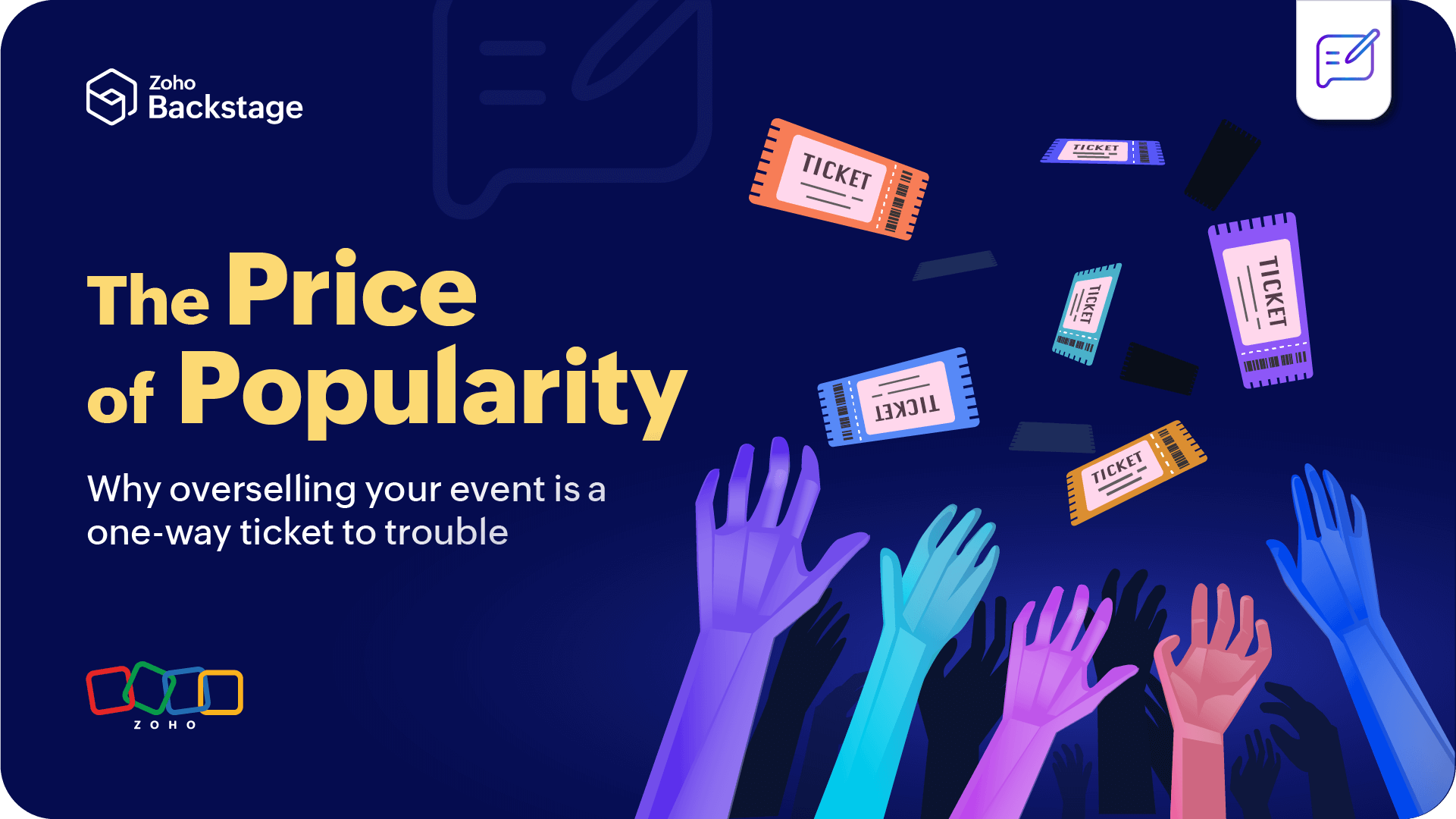9 KPIs to prove your event’s success
- Last Updated : August 18, 2023
- 3.3K Views
- 8 Min Read

According to a study by EventMB, 76% of today’s job ads for event professionals list measuring event success and judging the business value of events as a key responsibility. There are a lot of reasons for this—the data-driven world we live in, the marketer’s absolute trust in numbers, and the stress we lay on “quantifiable” to name just a few. For events, success is measured in Return on Investment (ROI), the number of leads gathered, revenue collected, and more.
Evaluating your event’s performance is quite easy these days, especially with the amount of event technology available. From event management software to CRM software and website analytics software, there are so many tools available in the market today to help you measure and quantify every aspect of your event and get a detailed report of your event’s ROI.
However, there are some event marketing Key Performance Indicators (KPIs) common to all events—both online and on-site—that can help you start measuring your event’s success and revenue more precisely. However, this doesn’t mean event analytics should be studied only after the event. Instead, it’s just the opposite. By being aware of the performance of your event at each stage, you can improve your strategy to make it a success. You should also set the goal of your event at the very beginning itself so you know which metrics to track and what methods to use to achieve that goal.
Here are nine of the most important KPIs every event planner should know (and track).
Registrations
The easiest way to measure your event’s performance is by tracking ticket sales—unless, of course, it’s a free event. Event registrations help you judge three aspects of your event—people’s interest in it, the effectiveness of your marketing strategy, and the attractiveness of the ticket prices. It also gives an idea of the revenue generated for the event.
A good event management tool can benefit you well here, especially if you wish to analyze the sales data on a granular level. You can further segment your registration data into different categories to get a more in-depth idea of your sales. Break down your sales based on ticket type, ticket price, promotional codes used, and even the marketing source (affiliates, social platforms, etc.) to find out what works and what doesn’t.
Subscribe to The Green Room
Sign up here and get all the most relevant MICE industry content delivered right to your inbox once a month.
By submitting this form, you agree to the processing of personal data according to our Privacy policy.
Event attendance
It’s a rare event where the total registrations match the event attendance. Most always, there’ll be a discrepancy between the two numbers—the number of people who checked-in will be lower than the number of people who registered. This is quite common. However, if the difference is large, you have a problem.
In event lingo, this is called the attrition rate. Divide the number of no-shows by the total registrants and multiply it by 100 to get the attrition rate for your event. For free events—as the incentive to attend is less—the attrition rate could be as high as 50%. For paid events, this rate is a lot less as people are invested in the event (they’ve spent money on it). Also, it’s important to not just track your no-shows, but also get them to give you a reason for not attending. Find a pattern in these reasons and you can find out what’s wrong with your event.
Session engagement
Your sessions and the speakers you’ve lined up are your event’s biggest attractions. They’re the reason people are signing up for it. So if your sessions are a hit with your attendees, your event is a hit with them. Some ways to measure the success of your sessions include:
Session attendance – Get attendees to register and check in for each session. This can be done with the help of good event management software.
Session feedback – Ask attendees to give their feedback for each session. Request them to rate the session and give feedback for it. Event apps can make this task especially easy.
Speaker engagement – Find out if a speaker resonated with your attendees by checking the number of profile views they got on your event website and how many people engaged with a particular speaker on your event app. You can then make a note to invite these speakers for future sessions.
Other things you can do are noting how many people added the session to their calendars and if there’s talk about the session on social media.
Social media impressions
Almost everyone has begun to market their events on social platforms. However, not many of them measure the impact of their social media campaigns—at least not as diligently as they do it with their brands and organizations. Social media analytics is an afterthought with events. Yet, it’s got so many possibilities. Social listening is as important for your event as it is for your organization. With a unique hashtag and a social listening dashboard set up for your event, you can analyze how your event is performing and discover new ways to promote it to the right audience. You can use tools like Hootsuite, Sprout Social, and Zoho Social to get this done.
Two other important social media metrics to look out for are mentions and engagement. The former is where your audience and followers tag or mention your event’s account in their posts. The latter is them liking, sharing, and commenting on your posts. These metrics can help you understand your event’s popularity before and after your event. They also tell you how effective your social media strategy is.
One other thing you can do to measure the effectiveness of your social media strategy is to have dedicated promotional codes for each social platform. This is an easy way to find out the effectiveness of your social platforms, not to mention the source of your registrations.
Sponsorship
A lot of events depend on sponsors for financial backing. Sponsor satisfaction and sponsorship revenue are two ways to find out if your sponsorship strategy went well. For this you should do two things—ensure that you keep your word to your sponsors (give them the benefits they promised) and give them the profit they need. Simply telling them their target market will be present at your event will not do.
On average, most sponsors expect an ROI of at least 2:1; so, for a $10,000 investment, they’d expect a minimum of $20,000 in return. Some brands expect an even bigger return. So by delivering sponsorship value, you don’t just prove the success of your event—you also ensure that they’ll be willing to sponsor your next event.
Attendee satisfaction
Everyone knows attendee satisfaction is the end goal of an event. And the happier the attendee, the more successful the event. How do you know if your attendees are satisfied? You ask them—through surveys, ratings, and feedback. Get them to rate the speakers and sessions and give feedback for both. Then, at the end of the event, get them to fill out a survey. Ask them about every aspect of the event—what should remain the same and what should change. Frame your survey in such a way that it enables you to get detailed responses from your attendees. This will help you get deeper insights into your event. Prove that your attendees were satisfied and you prove that your event was a success. It’s that simple, really!
Website analytics
Your event’s website houses an incredible amount of beneficial data that can help you understand your event, your target market, and even your sponsors better. All you have to do is tap into it. A free tool like Google Analytics would do to start with. Then you can track some simple metrics like:
Website traffic
Most-viewed pages, speakers, and sponsors
Bounce rate (how many people opened your website only to leave a second later)
Returning visitors
You can set goals to measure how many times a particular button or link was clicked or use Heatmaps to find out which parts of your website visitors were most focused on. All of this data can help you understand your attendees’ interests and modify your event website and event accordingly.
Leads acquired
Most organizations host events with one goal in mind—acquiring leads. So this can be a key indicator to evaluate an event’s success, at least with corporate and B2B events that depend on event marketing for lead generation. Keep track of the number of leads and referrals and follow up with them after the event. And when the time is right, approach them and convert them into customers.
Later on, you can even divide the number of customers you got from that particular event by the total expenditure of the event to calculate how much you’ve spent on acquiring each customer. This is a long process, but it is also the most granular way of deciding if your event proved to be a success. You can use CRM software—integrated with your event management platform—to help you track leads and conversions.
Net Promoter Score (NPS)
In your post-event survey, you’re likely to ask your attendees a bunch of questions ranging from whether they found the lunch buffet good to which speaker caught their attention and everything in between. The Net Promoter Score (NPS) is derived from just one question you should include in your survey: On a scale of 1-10, how likely are you to recommend this event to others?
If the answer is 9 or 10, they’re promoters (people who loved your event). The 8s and the 7s are passives (they’re people who liked your event but weren’t exactly wowed by it). If the score is 6 or below, they are the detractors (they didn’t find your event satisfying).
To calculate your NPS, you will have to subtract the percentage of detractors from the percentage of promoters (%promoters – %detractors). This will tell you how much of an impact your event left on your attendees—something all stakeholders will want to know.
These metrics can go a long way in validating your event’s success to clients, investors, and other stakeholders. The next time someone asks you if your event was a success, you can show them the numbers. And this time they will have to believe you. Because everyone knows numbers don’t lie.
If, like us, you're more of a social person, let's connect on Twitter (@ZohoBackstage) and we'll keep you up-to-date with all the latest event news.
 Nisha
NishaMarketing and content at Zoho Backstage. Cultural misfit. Armchair traveler. Productivity geek. Sometimes, I write poetry. Sometimes, it rhymes.








